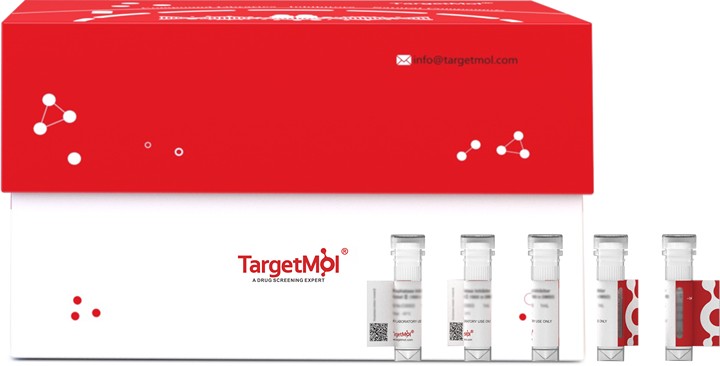Shopping Cart
Remove All Your shopping cart is currently empty
Your shopping cart is currently empty
Catalyzes two activities which are involved in the biotine biosynthesis: the conversion of dethiobiotin (DTB) to biotin by the insertion of a sulfur atom into dethiobiotin via a radical-based mechanism, and the transfer of the alpha-amino group from S-adenosyl-L-methionine (SAM) to 7-keto-8-aminopelargonic acid (KAPA) to form 7,8-diaminopelargonic acid (DAPA). BioAB Protein, Bacteroides fragilis, Recombinant (His & Myc) is expressed in E. coli expression system with N-10xHis and C-Myc tag. The predicted molecular weight is 90.6 kDa and the accession number is Q5LEY1.

| Pack Size | Price | USA Warehouse | Global Warehouse | Quantity |
|---|---|---|---|---|
| 5 μg | $129 | 20 days | 20 days | |
| 10 μg | $216 | 20 days | 20 days | |
| 20 μg | $360 | 20 days | 20 days | |
| 50 μg | $543 | 20 days | 20 days | |
| 100 μg | $745 | 20 days | 20 days | |
| 200 μg | $1,070 | 20 days | 20 days | |
| 500 μg | $1,730 | 20 days | 20 days | |
| 1 mg | $2,530 | 20 days | 20 days |
| Biological Activity | Activity has not been tested. It is theoretically active, but we cannot guarantee it. If you require protein activity, we recommend choosing the eukaryotic expression version first. |
| Description | Catalyzes two activities which are involved in the biotine biosynthesis: the conversion of dethiobiotin (DTB) to biotin by the insertion of a sulfur atom into dethiobiotin via a radical-based mechanism, and the transfer of the alpha-amino group from S-adenosyl-L-methionine (SAM) to 7-keto-8-aminopelargonic acid (KAPA) to form 7,8-diaminopelargonic acid (DAPA). BioAB Protein, Bacteroides fragilis, Recombinant (His & Myc) is expressed in E. coli expression system with N-10xHis and C-Myc tag. The predicted molecular weight is 90.6 kDa and the accession number is Q5LEY1. |
| Species | Bacteroides fragilis |
| Expression System | E. coli |
| Tag | N-10xHis, C-Myc |
| Accession Number | Q5LEY1 |
| Synonyms | Biotin biosynthesis bifunctional protein BioAB,bioB |
| Amino Acid | MTIEEIKNQVLQGTAISREQAEWLALYPRKEELYDAAHDITTACASQEFDMCSIINARSGRCPENCKWCAQSSHYKTKADVYDLVSADECLRQAKYNEAQGVNRFSLVTSGRKPSPKNMKELCVAARRMRRHSSIRLCASLGLLDEEELQALYDAGVTRYHCNLETAPSHFDSLCTTHTQEQKLKTLHAARRVGMDLCCGGIIGMGETVEQRIEFAFTLRDLNIQSIPINLLQPIPGTPLEHQSPLSEEEILTTVALFRFINPAAYLRFAGGRSQLTPEAVRKSLYIGINSAIVGDLLTTLGSKVSDDKEMILSEGYHFADSQFDREHLWHPYTSTSNPLPVYKVKRADGATITLESGQTLIEGMSSWWCAVHGYNHPILNQAVQDQLSRMSHVMFGGLTHDPAIELGKLLLPLVPPSMQKIFYADSGSVAVEVALKMAVQYWYAAGKPEKNNFVTIRNGYHGDTWNAMSVCDPVTGMHSIFGSALPIRHFLPAPSSRFGDEWNPEDIRPLEYLLEKHADELAAFILEPIVQGAGGMRFYHPEYLKEAARLCHRYGVLLIFDEIATGFGRTGKLFAWEHAGVEPDIMCIGKALTGGYMTLSAVLTTNEVADCISNHAPGAFMHGPTFMGNPLACAVACASVRLLLTSGWQENVKRIEAQLNRELAPARELPQVADVRVLGAIGVIEMKEPVNMAYLQRRFVEEGIWLRPFGKLIYVMPPFIITPEQLTKLTEGMIRIISNGLPGSQTK |
| Construction | 1-748 aa |
| Protein Purity | > 85% as determined by SDS-PAGE. |
| Molecular Weight | 90.6 kDa (predicted) |
| Endotoxin | < 1.0 EU/μg of the protein as determined by the LAL method. |
| Formulation | If the delivery form is liquid, the default storage buffer is Tris/PBS-based buffer, 5%-50% glycerol. If the delivery form is lyophilized powder, the buffer before lyophilization is Tris/PBS-based buffer, 6% Trehalose, pH 8.0. |
| Reconstitution | Reconstitute the lyophilized protein in sterile deionized water. The product concentration should not be less than 100 μg/mL. Before opening, centrifuge the tube to collect powder at the bottom. After adding the reconstitution buffer, avoid vortexing or pipetting for mixing. |
| Stability & Storage | Lyophilized powders can be stably stored for over 12 months, while liquid products can be stored for 6-12 months at -80°C. For reconstituted protein solutions, the solution can be stored at -20°C to -80°C for at least 3 months. Please avoid multiple freeze-thaw cycles and store products in aliquots. |
| Shipping | In general, Lyophilized powders are shipping with blue ice. Solutions are shipping with dry ice. |
| Research Background | Catalyzes two activities which are involved in the biotine biosynthesis: the conversion of dethiobiotin (DTB) to biotin by the insertion of a sulfur atom into dethiobiotin via a radical-based mechanism, and the transfer of the alpha-amino group from S-adenosyl-L-methionine (SAM) to 7-keto-8-aminopelargonic acid (KAPA) to form 7,8-diaminopelargonic acid (DAPA). |
| Size | Quantity | Unit Price | Amount | Operation |
|---|

Copyright © 2015-2025 TargetMol Chemicals Inc. All Rights Reserved.